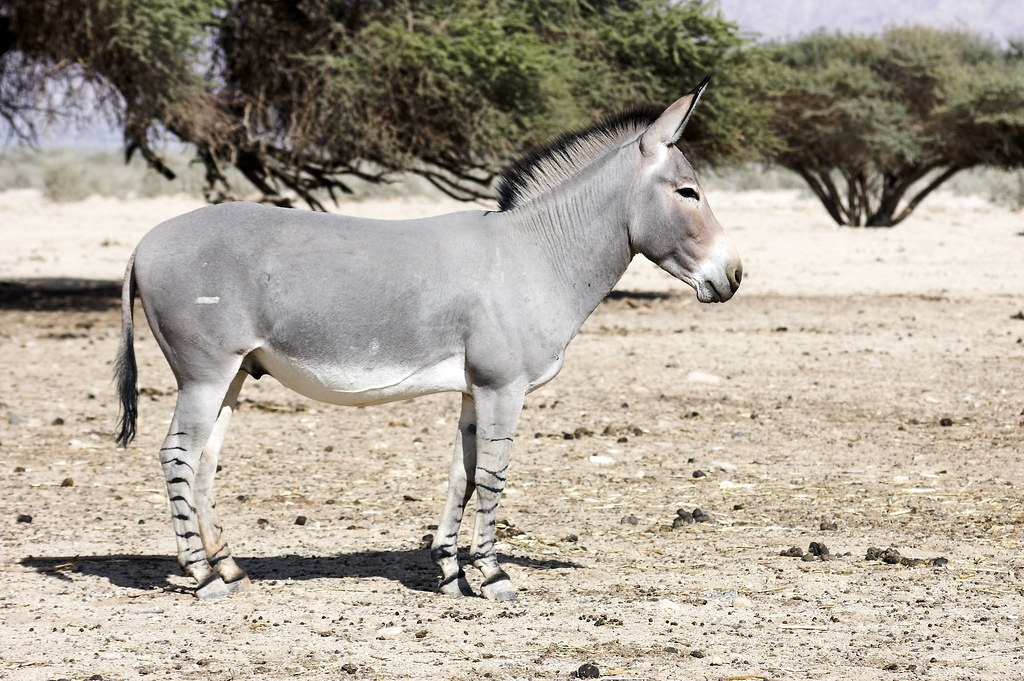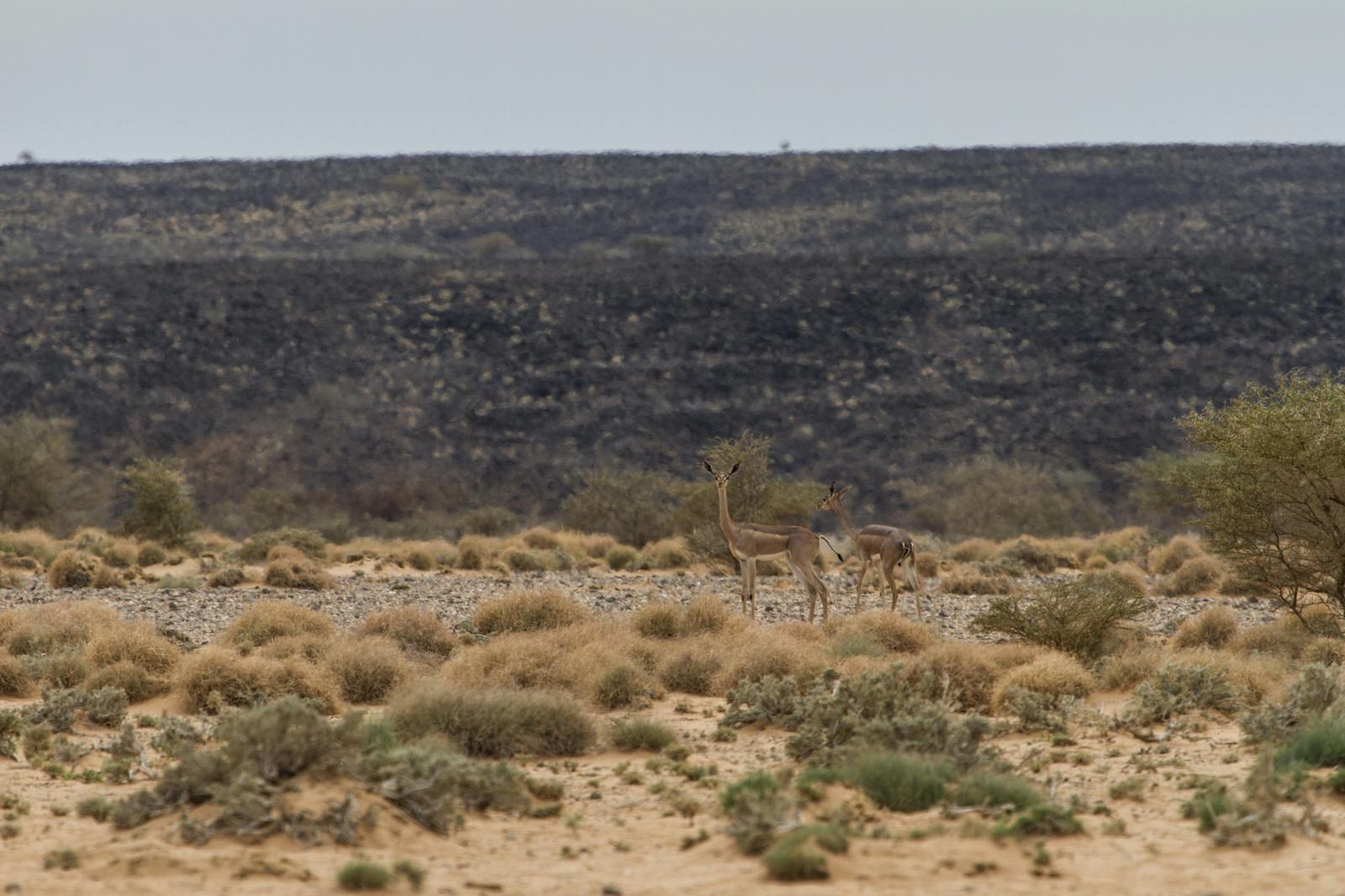Djibouti Xeric Shrublands
The ecoregion’s land area is provided in units of 1,000 hectares. The protection goal is the Global Safety Net (GSN1) area for the given ecoregion. The protection level indicates the percentage of the GSN goal that is currently protected on a scale of 0-10. N/A means data is not available at this time.
Bioregion: South Red Sea & Gulf of Aden Coastal Drylands (AT22)
Realm: Afrotropics
Ecoregion Size (1000 ha):
23,818
Ecoregion ID:
92
Protection Goal:
33%
Protection Level:
5
States: Sudan, Eritrea, Djibouti, Ethiopia, Somalia
The African wild ass is the most endangered wild equid in the world. Only relict populations remain in the Danakil Desert in Ethiopia, as well as in Eritrea and Israel. Their population numbers have dramatically reduced and there have been local extinctions primarily because they are hunted for food and traditional medicine. For example, there is high demand from China for donkey hides, ejiao, for use in medicines. Domesticated livestock in the area also compete with the endangered equid for the limited water sources.
The ecoregion extends from the Sudanese-Eritrean border, south through Ethiopia to Djibouti, and eastwards into Somalia—in the Somaliland region of the country, as well as extending into the center of Ethiopia. It borders the Red Sea and the Gulf of Oman and includes the Dahlak Archipelago and some other islands. There are fault-induced depressions, such as the Danakil (Dallol) Depression and Lac Assal, lying as much as 160 m below sea level. The climate is very hot and dry.

The flagship species of the Djibouti Xeric Shrublands ecoregion is the African wild ass. Image credit: Creative Commons
Mean annual rainfall varies from less than 100 mm close to the coast to around 200 mm further inland. Mean minimum temperatures range from 21° to 24°C, and mean maximum temperature is around 30°C. In the Danakil depression, diurnal temperatures can range between 11 and 48°C with the hottest time between May and August. This is one of the hottest places in Africa and the world.
There are few permanent watercourses, with the most notable being the Awash River of Ethiopia that terminates in a series of saline lakes and salt flats near the border with Djibouti. The region is extremely active tectonically, and experiences many earthquakes because of the continuing expansion of the Rift Valley. There are also active volcanoes.
Along the coast in the east, mangroves occur in muddy areas, primarily around wadi "outwashes" and inlets, while further inland, vegetation changes to grass shrub steppe. Acacia mellifera and Rhigozum somalense dominate the basaltic lava fields while scattered Acacia tortilis, A. nubica, and Balanites aegyptiaca can be found in the sandy plains. Stands of Hyphaene thebaica occur in depressions and along wadis.
Phytogeographically, this ecoregion is a part of the Somali-Masai regional center of endemism. An estimated 825 to 950 plant species have been observed in Djibouti, although many of these have been found only in the small outlying patches of the Ethiopian montane forest at the Day Forest and Mabla Massif above 1,100 m.
The floral diversity of the Danakil Depression and its surroundings comprises 200 species of plants, of which around 25 species are endemic to this region and the adjacent equally dry parts of Ethiopia and Somalia. The dragon ombet and Bankoualé palm are notable plant species that do occur. Among mammals, desert ungulates are well represented.
The African wild ass survives in the Buri Peninsula area of central Eritrea; possibly the last viable population. Beira antelope occur where Djibouti, Ethiopia, and Somalia meet. Dorcas gazelle, Sömmerring's gazelle, Salt’s dikdik, and gerenuk are also still found. Beisa oryx persist, but the numbers have been greatly reduced by intense hunting pressure.
The reptilian fauna is relatively rich, but there is a poor avifauna and very few species of amphibian. In all vertebrates’ levels of endemism are low, with strict endemics limited to only one bird, Archer’s lark, a rodent, Berbera Gerbil, and two geckos, Arnold’s leaf-toed gecko, and a subspecies of the northern sand gecko.
The ecoregion contains only a few protected areas that suffer a lack of enforcement. Although large blocks of “natural” habitat remain, much has been degraded through over-exploitation. The protected areas in this ecoregion include Nafka Wildlife Reserve in Eritrea, Mile-Sardo, Awash West, and Gewane Wildlife Reserves, Awash West, Erer-Gota, and Afdem-Gewane Controlled Hunting Areas, Awash and Abijatta-Shalla Lakes National Parks, and Dengego-Melka Jedbu National Forest Priority Area in Ethiopia, Djalélo and Assamo Terrestrial Protected Areas in Djibouti.
There are no protected areas in Somalia.
The major threats are widespread overgrazing and tree cutting for fuel and timber, particularly around the increasingly permanent settlements. Clearance for agriculture along the few permanent watercourses is also a major problem. Ethiopia owns the largest livestock population in Africa and competition for scarce resources, including water and grazing land, causes conflict between pastoralists and wildlife managers.
This is particularly problematic during periods of drought when pastoralists migrate into protected areas, for example, around Awash National Park. Populations of most large mammal species have been severely reduced through hunting by local people.
The priority conservation actions for the next decade will be to: 1) implement community based wildlife management approaches; 2) establish more job opportunities through eco-tourism and other wildlife related activities as well as additional alternative livelihoods including honey production; and 3) continue training local pastoralists as scouts to prevent poaching of wildlife.
Citations
1. Burgess, N., Hales, J.A., Underwood, E., Dinerstein, E., Olson, D., Itoua, I., Schipper, J., Ricketts, T. and Newman, K. 2004. Terrestrial ecoregions of Africa and Madagascar: a conservation assessment. Island Press.
2. Kebede, F., Moehlman, P.D., Bekele, A. and Evangelista, P.H. 2014. Predicting seasonal habitat suitability for the critically endangered African wild ass in the Danakil, Ethiopia. African journal of ecology. 52(4), pp.533-542.
3. Biru, Y., Tessema, Z.K. and Urge, M. 2017. Perception and attitude of pastoralists on livestock-wildlife interactions around Awash National Park, Ethiopia: implication for biodiversity conservation. Ecological Processes. 6(1), p.13.
4. Dejene, S.W., Seyoum, H. and Ready, R.U. 2014. Ecotourism potential and its role for sustainable development and livelihood in Awash National Park, Ethiopia. Int J Sci Res. 3(12), pp.792-796.



